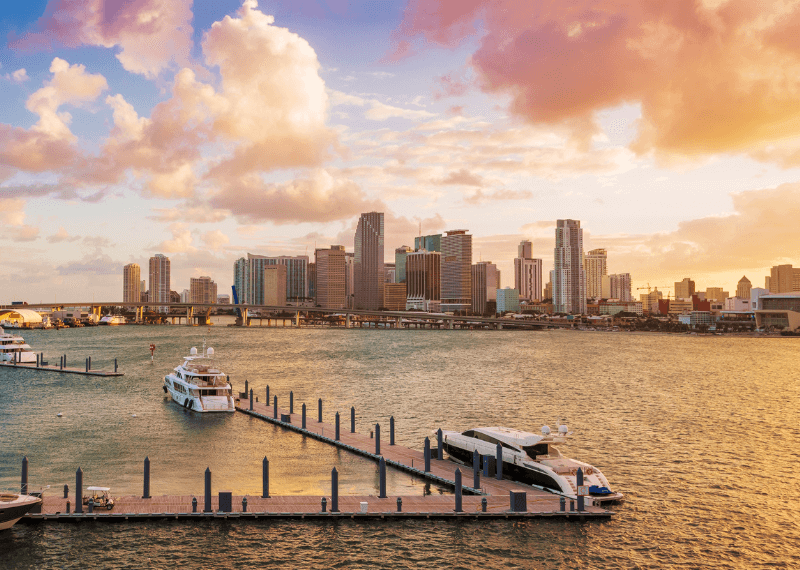This Miami cost guide explores the main expenses of living in the heart of Miami, from rent to food and transportation. We review it all and give you a comprehensive overview to help you budget for life in the city that simply keeps sun and vodka flowing.
Miami Baby
Living in Miami, FL, combines sunshine, many cultures and languages, and very high living costs for high standards of living.
As one of the most sunny and wanted cities in the U.S., Miami offers a great blend of tropical weather, a great and growing job market, and a beachy lifestyle.
That being said, the cost of living can be higher than the national average and even prohibitive, with high housing and driving costs.
Cost of Living in Miami, FL: A Detailed Guide
Miami is a very special blend of luxury and lifestyle. Known for its beaches, incredible concerts and nightlife, and international business scene, it attracts people from all over the world of all financial standings. With this sexy allure comes a cost: a higher-than-average cost of living.
Whether you’re considering a move to Miami or just curious about the expenses to do something like this, this guide will break down what you need to consider when figuring the cost of living in Miami.
1. Housing
The cost of housing is by far the largest expense here in Miami. Whether you’re renting or buying, prices are way higher than in many other U.S. cities. Miami’s real estate market is highly competitive due to its sunny climate and fun parties.
Renting in Miami
Renting in Miami depends on the neighborhood and type of home you want. The best and coolest areas like Brickell, and Miami Beach have higher rent prices due to their location and proximity to the beach, work, and nightlife.
Average prices so you can get an idea:
- 1-Bedroom Apartment in the City Center: $2,700 – $3,500 per month
- 1-Bedroom Apartment Outside the City Center: $1,900 – $2,500 per month
- 3-Bedroom Apartment in the City Center: $4,000 – $6,500 per month
- 3-Bedroom Apartment Outside the City Center: $2,800 – $4,500 per month
The price always based on location, the street itself and noise levels, size, and other amenities. Depending on the location and if there is an ocean view, the cost will be significantly more than an apartment in less central locations. This is true for everywhere.
Buying a Home in Miami (If you dare)
Miami’s real estate market can be daunting and expensive, with the average home price around $600,000 – $800,000. Depending on the neighborhood and size of the home this can also be much higher.
Homes in highly desired areas like Coral Gables or Miami Beach will cost over a million dollars easily and way more depending on the level of luxury you desire.
- Average Home Price in Miami: $735,000
- Condo Price: $550,000 – $700,000 (depending on size and location)
2. Utilities and Internet
Miami’s utilities are more expensive than in other cities due to its hot temperatures and high energy demand, especially during summer months you should expect to pay more. On average, you can expect, It’s important to note that air conditioning will be a significant portion of your energy bill during the hot summer months.
- Electricity, Heating, Cooling, Water, Trash: $150 – $350 per month (for a standard apartment)
- Internet: $60 – $100 per month
3. Getting Around
Miami has a public transportation system, but it’s limited compared to other major cities. As a result, you will need your own car here realistically. Here is a breakdown of average costs to having your own private car.
Owning a Car
- Gas: The average price of gas in Miami is typically around $3.30 – $3.70 per gallon depending on the cost of a barrel.
- Car Insurance: Miami’s car insurance tends to be higher than the national average.
- Expect to pay around 1,200 – $2,000 per year, depending on your driving history and the type of car you have.
- Parking: Parking can be expensive, especially in the downtown or beach areas. If you live in an area with limited street parking, expect to pay $100- $300 per month as a minimum. If there is a concert or big event in the area expect to pay even high prices from $40 and up in the downtown.
Public Transportation Prices:
- Monthly Public Transport Pass: $112 per month
- One-Way Ticket: $2.25
While public transit is available, the city is known for its heavy traffic, so owning a car may still be more convenient even if you do partially use the public options.
4. Food
Wow the food in Miami is incredible! You have it all from Latin American eateries to upscale restaurants for teh rich and famous. For grocery shopping, prices are slightly higher than the national average, mainly due to the city’s tropical location and demand for imported goods. I fyou are spending most of your salary on food don’t be surprised as it is just delicious here.
Grocery Prices in Miami
- Milk (1 gallon): $4.00
- Bread (1 loaf): $4.00
- Eggs (12): $4.00
- Rice (1 kg): $5.00
- Chicken (1 kg): $12.00
- Apples (1 kg): $5.00
While grocery prices vary depending on where you shop, local markets vs. big chain stores, overall the prices of cooking at home are necessarily that cheap. As well, eating out in Miami can get expensive very quickly. My local suggestion is to find you favorite $1 tacos and gain weight in the most fun way possible.
Eating Out:
- Inexpensive Restaurant: $15 – $25
- Mid-Range $60 – $100
- Luxury $ could be up to $2000 for one, the sky is the limit
- Coffee (Regular): $5
Miami has a perfect and diverse food scene, especially when it comes to Latin American and Caribbean cuisine, you have some of the best options in the USA. This making eating out both an experience and an expense. Save up as this is the best part of living in Miami in my opinion.
5. Health and Fitness is Key in Miami
- Health Insurance: $300 – $600 depending on your employer
- Gym Membership: $40 – $100 per month without classes
- Gym Classes: $30 per group class
- Doctor’s Visit: $200 per visit
Miami gyms are a vibe but the costs add up quite fast. This is the most important thing though after hitting up that taco stand.
6. Fun In The City
Miami locals know that fun is a big part of the lifestyle. From beach outings to night clubs, art galleries, and theater, there’s always something to do. The DJs that make it here are top class. Here are the average prices for a night out:
- Movie Ticket: $16
- Night Out cocktails and dinner for two: $50 – $150
- Museum Admission: $20
Miami Wrap
Living in Miami comes with its share of costs, especially for housing, and getting around. On average, you can expect to pay more for rent, car insurance, and groceries than the national average. However, with its sunny weather,fun party lifestyle, and the best beaches in the USA, many people find the cost of living worth it.
If you are moving to Miami, it’s essential to factor in these expenses into your budget to ensure your salary covers it. Consider your housing options and potentially moving out of the city, transportation needs, and food choices when planning your finances in this awesome Miami downtown.
Frequently Asked Questions
Is Miami expensive to live in?
Yes, very expensive. Miami has a very high cost of living, especially in terms of housing, and transportation. Everything depends on location and lifestyle choices, but overall, Miami is one of the most expensive cities to live in.
What is the average rent in Miami?
Rent prices in Miami vary by area, but on average, a 1-bedroom apartment in the center costs around $2,500 – $3,500 per month. Don’t forget to factor in the costs of food and restaurants.
How much does it cost to buy a home in Miami?
The average home price in Miami is around $535,000 for a 3 bedroom place, although prices can go much higher as you get closer to the sea. Most families choose to rent as buying isn’t feasible for most.
Are groceries expensive in Miami?
Yes, they are. Grocery prices in Miami are above the national average, especially for fresh produce which is mostly grown out of state.
Is it possible to get around Miami without a car?
It is possible but not ideal. While Miami has public transportation options, like buses and the Metrorail, the city’s traffic and infrastructure often make owning a car more practical, especially for long-distance needs. If you work even slightly outside the city you will find you need a car to arrive on time for work.




